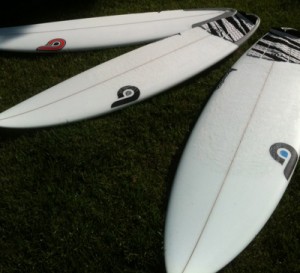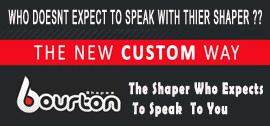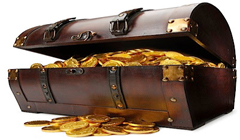THE BOTTOM FEEDER The goal with the Bottom feeder is to appeal to the surfer who has ignored the fish angle for small waves and offer him a very high performance small wave thruster along the lines of what the pros would pull out when it is tiny. Luke Munro gave me some great feedback on a groveller that I made him for Europe and Brazil the year he requalified, so I thought it prudent to start with his file as a base to design from. Luke has always liked his concaves deep and with this shortie we deepened it even more – 6 mm in front of the fins with a slight double built in but not overpowering. The principal of having the deepest section of the concave between the front and back feet is obviously because this is where all the pressure is exerted and the kickback lift when rail to railing helps keep the board on the surface when there is little or no speed in the wave force itself.

It is well known that when you stop turning a concave it will sink and slow and catch. The real trick to this design is the rocker. I have lowered the nose rocker down below that of normal high performance thrusters and as a consequence flipped the tail in the last 18 inches This combination of low nose entry – front foot speed, and extreme tail flip – impulsive vert allows this design to run with no power and still retain the facility to be sent vertical on impulse . For those who understand stringer curve and rail line curve, would know that with concaves the rail line has more curve than the stringer line and it is the opposite with vees. By having a 6mm deep concave around the front fin area reducing to 1mm at the tail end creates quite a bit of rail line curve running out the last 12 inches .
When on rail- in turn mode, you have more curve on the rail to work with around your back foot encouraging even tighter arcs in the power pockets when you can find them, and this is where you can showcase some big moves in shitty little waves when the opportunity presents itself, simply because this board will let you ! DH has tackled this the opposite way with his project 15 grovellers where he has kept the rocker out the tail much straighter for more projection and used excess planshape curve in the last 18 inches to give back east west manoeuvrability. Just goes to show you there is more ways than one to skin a cat.
The Bottom Feeder is wider all round and has a subtle hip into a reasonably wide squash tail. I have kept my head here though ,since I have seen many of these types of boards where the pod is too wide and the pressures on the fins – particularly on the rear fin, are too much and as a result the board needs to be nursed especially in those little power pockets. Remember this is a high performance design.
The best rail design for slow speeds is the small box rail. The boxy shape does not over penetrate, but the fact that it is not too thick (running off a medium veed deck) it is still easily buried, but not over buried. The point of this in small waves is that to pump up a deep concave in order to keep the board running along the surface, there needs to be lots of ins and outs with the busy rail to rail pump so the rail needs to bury but release quickly in order to get on with the next move.
THE UPDATED FEEDER 2014-15
The name” Bottom Feeder”in retrospect for this model proved to be a little off the mark, and although it was born during the skinny thruster pandemic and had that wider boxier look the world soon caught up with the Slater downsize shift sweeping into popularity- making the original Bottom Feeder look a little like what it was trying to escape. The term Bottom Feeder really means a design for small gutless waves but these days with some of the super wide, short and flatter designs that are getting around, the Feeder finds itself being elbowed out of that market.
It has really been a blessing since most of those flat slabs are fast but stiff leaving the way open for a performance thruster like the Feeder that has been designed to run and pivot in smaller waves that have at least a little energy in them. The updated 2014-15 Feeder has had its nose and tail widened and central planshape made a little more parallel for some more run, and also has a more punctuated hip to give it some added release since I have reduced the tail flip a tad.
It has the same dimensions as last years but these tweaks have enhanced its performance in 2 feet to 5 feet conditions. This model has been my most popular performance thruster the last few years and has deserved this makeover and probably a new name as well! Will sit on it though- don’t need to confuse the market any more.
DIMENSIONS
5.8 X 18 3/4 X 2 3/16 – 24.59L
5.10 X 19 X 2 3/16 – 25.57L
6.0 X 19 1/4 X 2 5/16 – 27.84L
6.2 X 19 1/2 X 2 3/8 – 29.78L
6.4 X 19 ¾ X 2 1/2 – 32.45L
———————————————————-
Hey Muzz,
Tons of thanks for my new boards, I picked up my new boards yesterday, felt great under my arm, and these boards came out nice and light…….
 I woke up this morning to a surprise early South Swell, Muzz, the 5’9″ Bottom Feeder goes off, soooooooooooo stoked, thing rode absolutely insane. After a two hour rip session on the Bottom Feeder, switched boards and rode 5’10” round pin with Tri/Quad option, and again this board also rode insane, these are keepers for sure. I may have order another Bottom Feeder for a back up, love this board off the top, this board is super sick…………….serious really love this one, super sick!
I woke up this morning to a surprise early South Swell, Muzz, the 5’9″ Bottom Feeder goes off, soooooooooooo stoked, thing rode absolutely insane. After a two hour rip session on the Bottom Feeder, switched boards and rode 5’10” round pin with Tri/Quad option, and again this board also rode insane, these are keepers for sure. I may have order another Bottom Feeder for a back up, love this board off the top, this board is super sick…………….serious really love this one, super sick!
Thanks heaps Muzz,
Next time in US would like to hook up for a beer, either that or I am coming to see you soon.
Cheers
Tezza
———————————————————————-
I have ridden Murray’s boards for over twenty years.
The bottom feeder is by far the best board I’ve ever ridden. The bottom feeder is high performance yet a very easy board to ride. It’s extremely responsive and quick from the take off with quick and easy release out of the pocket. From there, the bottom feeder has excellent rail to rail transition whether you are surfing down the line or straight up and down.
I usually ride my 5 “11 a little wider in areas for around the 1 to 4 feet range. With the same plan ,the bottom feeder , I ride 6 “1 and refine the board in areas for the 5 feet plus range,. I highly recommed letting Murray work on the finer details.
The bottom feeder enables me to surf all conditions whether it’s beach breaks, point breaks or reef .
thanks muzz
Dean Walpole


